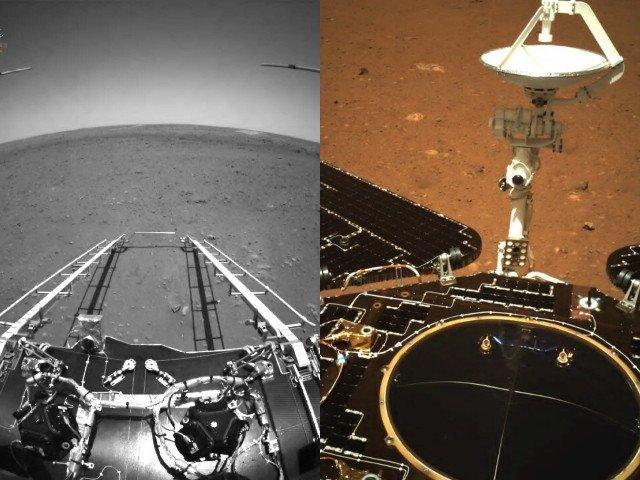
Image Courtesy: AFP
There has been interesting news from Mars in a week are where China's Zhurong rover sent back a set of new images from Mars, including a selfie, and NASA's Ingenuity helicopter kicked up dust in its flight, an event which will offer scientists more information about the Martian atmosphere.
ZHURONG’S SELFIE
The Zhurong rover was carried to Mars as part of the Tianwen-1 mission launched by China National Space Administration (CNSA) to Mars on July 23, 2020. The mission aims to study the geology and topology of the planet, sample the Martian atmosphere and examine indications of the presence of water in the planet. The rover drove onto the Martian surface on May 22.
Zhurong has sent back a new set of images from Mars that included a selfie. It had sent its first images of Mars back in May after having landed a few days earlier.
The new pictures included a 360-degree panorama of the landing area. The panorama photograph was stitched together from a number of images Zhurong captured after it had landed and began to move in the area, according to the Chinese news agency Xinhua.
Another image showed the orange Martian surface where scattered rocks, a circular crater and dunes were visible in the distance. The six-wheeled solar vehicle has a rocket powered platform to its right which it deploys for a soft landing.
The images depict its nearby area to be relatively flat with rocks that are partially buried and light-coloured. These rocks are of various sizes and have smooth surface edges.
The Chinese rover landed on Utopia Planitia, a region in the northern hemisphere of the planet.
Zhurong rover is equipped with six scientific instruments – ground-penetrating radar with a capacity of imaging about 100 metres below the surface of Mars; a surface magnetic field detector; Mars climate station including thermometer, anemometer (a device to measure wind speed and direction) and a pressure sensor; Mars surface compound detector (this instrument has infrared spectroscopy and laser-induced breakdown spectroscopy); multi-spectrum cameras, and navigation and topography cameras.
INGENUITY KICKS UP DUST IN ITS FOURTH FLIGHT
The Perseverance rover by NASA contains a tiny helicopter called the ‘Ingenuity’. It is built with the aim for it to travel in the exploration zone and gather information. Ingenuity has already made a few such flights. According to a recent release by the Jet Propulsion Laboratory, NASA said that at the end of fourth flight, the kicking up of dust by its spinning rotors was observed. When the tiny chopper whizzes through the planet's air, its rotating blades sometimes stir up a dust cloud that envelops it and travels with it.
Scientists have reportedly observed dust whirling beneath the chopper in several videos, even when it was flying about five metres above the Martian surface. The phenomenon suggests that dust can get blown up and transported in the Martian air more easily than it was thought earlier.
The kicking up of dust when a chopper takes off or lands is not surprising in a dusty planet like Mars. But what is intriguing is how the dust interacts with the chopper during its flight. By observing how the dust travels along scientists hope to better understand the dynamics of the thin atmosphere of Mars. Tornado-like dust events often form in the planet when the air is heated up by the Sun.
Dust was indeed kicked up in the first two flights made by Ingenuity, but it did not travel far from the point of take-off. But, on the third flight, when the helicopter rose above five feet from the ground, the dust cloud flew over on the surface of Mars.
Its fourth flight was intriguing for the scientists. The video recorded by Perseverance showed that the helicopter rose and disappeared from view. After a while it reappeared, enveloped in an enormous cloud of dust. The video showed that the dust was travelling beneath the helicopter.
Ingenuity had made eight flights of different distances till June 8. Perseverance is exploring the Jezero Crater to find the presence of ancient life. The Jezero Crater is considered to be one of the best places for such explorations. The 45-kilometre wide crater had a big lake and a river delta, formed billions of years ago.
Comments
Post a Comment